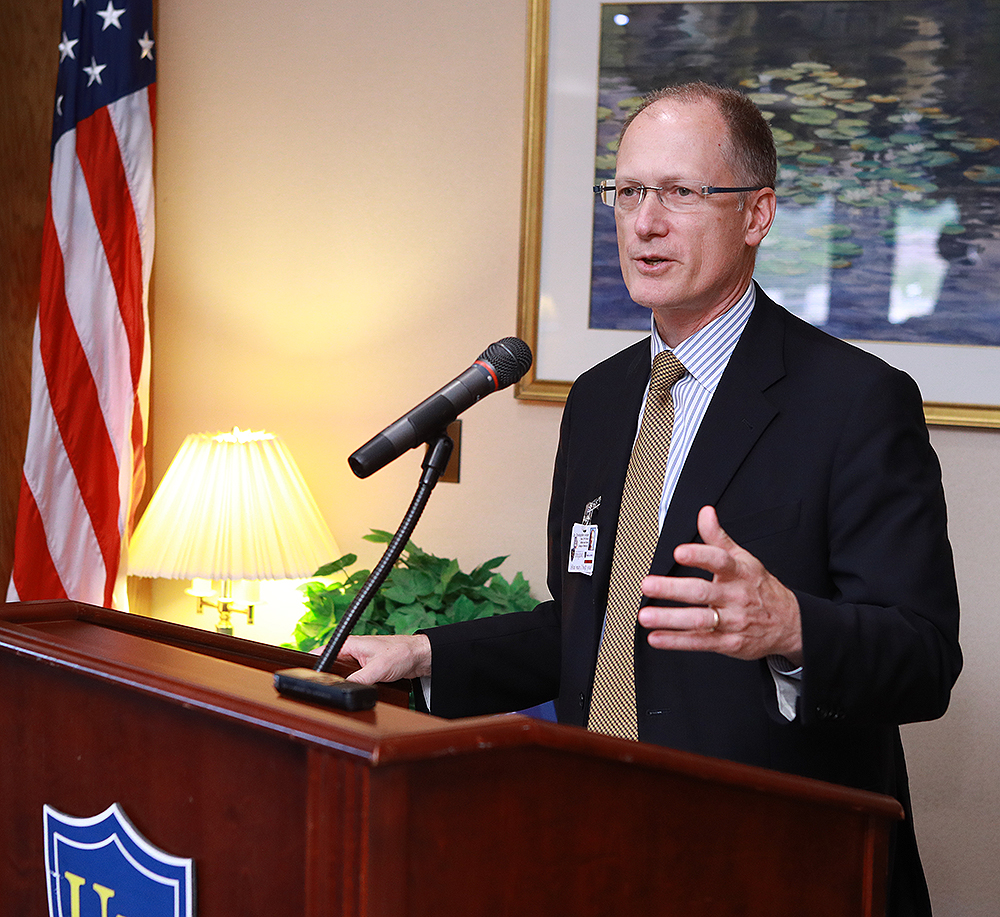Former dean Clyde Balch memorialized in bronze bust
By Laurie B. Davis

“I know if we surveyed people around The University of Toledo campus, about 99 percent wouldn’t know who Clyde Balch was, other than it’s a name on an auditorium,” said Dr. Charles M. Balch (A/S, ’64), speaking at an event held on Wednesday, May 23 to unveil the bust of his father.
The late dean’s family members, especially his son, Charles, who commissioned the 3-D portrait, envision students rubbing the head of Clyde’s portrait as they pass by. “We’ve all said that once the bust is placed, if people touch the head, that’s going to bring them good luck in their career. It will be like the Blarney Stone,” said Balch,
“I think it’s important to capture the history of people who have contributed so much to the University, so they in turn can inspire other people, especially the students,” Balch said. “I hope students will think, ‘If this person can rise to leadership and create new programs, then maybe I can do that, too.’”
Balch described his father as a visionary and entrepreneur. “One of Clyde’s main characteristics was that he wanted to start things that had value and were durable,” said Balch. He liked creating new products for commercialization, such as he did by helping develop the process for the commercial production of saccharine. And the College of Adult and Continuing Education, which he advanced as its founding dean, continues today as University College.
Mastering a likeness

While the plaque attached to the sculpture’s pedestal highlights Clyde Balch’s historical contributions to The University of Toledo, the bust itself captures his likeness. “When I first met Charles,” said Lingeman, “I saw him from a block away. I said, ‘that’s Charles, that’s the son of Clyde Balch. I felt as if I was on the right track with the likeness, and I think it turned out to be a successful rendering of the man, Clyde Balch.”

Lingeman noted, “The eyes were very important because Clyde was very expressive.” Occasionally, Lingeman would get input from his colleagues in the Department of Art. He asked his colleague Brian Carpenter, lecturer in interdisciplinary art and foundations and director of the Center for Visual Arts gallery, to assist with sculpting the eyes. Others in the department also assisted with the project, including Jerod Christy, 3-D technical assistant, alumnus Cameron McCloud (Comm/Arts ’16) and Eric Ziegler, lecturer in interdisciplinary art and foundations, who built the wood pedestal.
A story of families

After graduating from UT, Balch went on to medical school at Columbia University’s Vagelos College of Physicians and Surgeons. He distinguished himself as a leading cancer researcher and a surgeon who has been on the faculty of the University of Alabama, the University of Texas and The Johns Hopkins University. He has held leadership roles at M.D. Anderson Cancer Center, The City of Hope National Medical Center, and the American Society of Clinical Oncology.
“I can tell you that Dr. Balch is a consummate surgeon scientist,” said Brunicardi at the event. “He’s won 34 awards in his career. He is truly the world’s authority on melanoma. He’s a spectacular educator and has taught us about the guidelines of modern cancer care.”
Also addressing the guests was cardiologist Dr. Christopher Cooper, dean of the College of Medicine and Life Sciences. Cooper interpreted the gathering to honor Clyde Balch’s legacy as “a story of overlapping families. The Balch family has shared its treasure, time and talent. What you do for the University of Toledo is wonderful. It’s also a story about the University of Toledo family,” said Cooper, noting that Lingeman could lean on his fellow faculty members to contribute to the bronze project. Many of the art faculty also were in attendance to support their colleague’s project.
“What’s really cool is that we are a family. This is not the first time, this is not the second time, this is the third or fourth time that, as an example, this spring semester, I’ve been able to get together with my colleagues from the arts, and we do these wonderful collaborative things that make us better than any one of us individually.”

Like his father, Balch was a pioneer in his field, and the UT degrees the two men received, furthered their respective careers in engineering and medicine. In semi-retirement, both men have lectured professionally across the world. For his father and for himself, said Balch, traveling has been about giving back. “It’s about having a world view. We’re not just Americans, but we’re world citizens. It’s important for us to export our knowledge and provide professional services,” for the betterment of citizens in other countries, he said.
On the island of Bali in Indonesia, Clyde Balch consulted on the development of an engineering school, and Charles lectures about cancer research, its latest findings and the newest treatments being used for patients. So far in 2018, Balch has lectured in Korea, Egypt, China and Canada.
Balch hopes the presence of his father’s bronze portrait and his noteworthy accomplishments will inspire UT students to also “aim high.”






